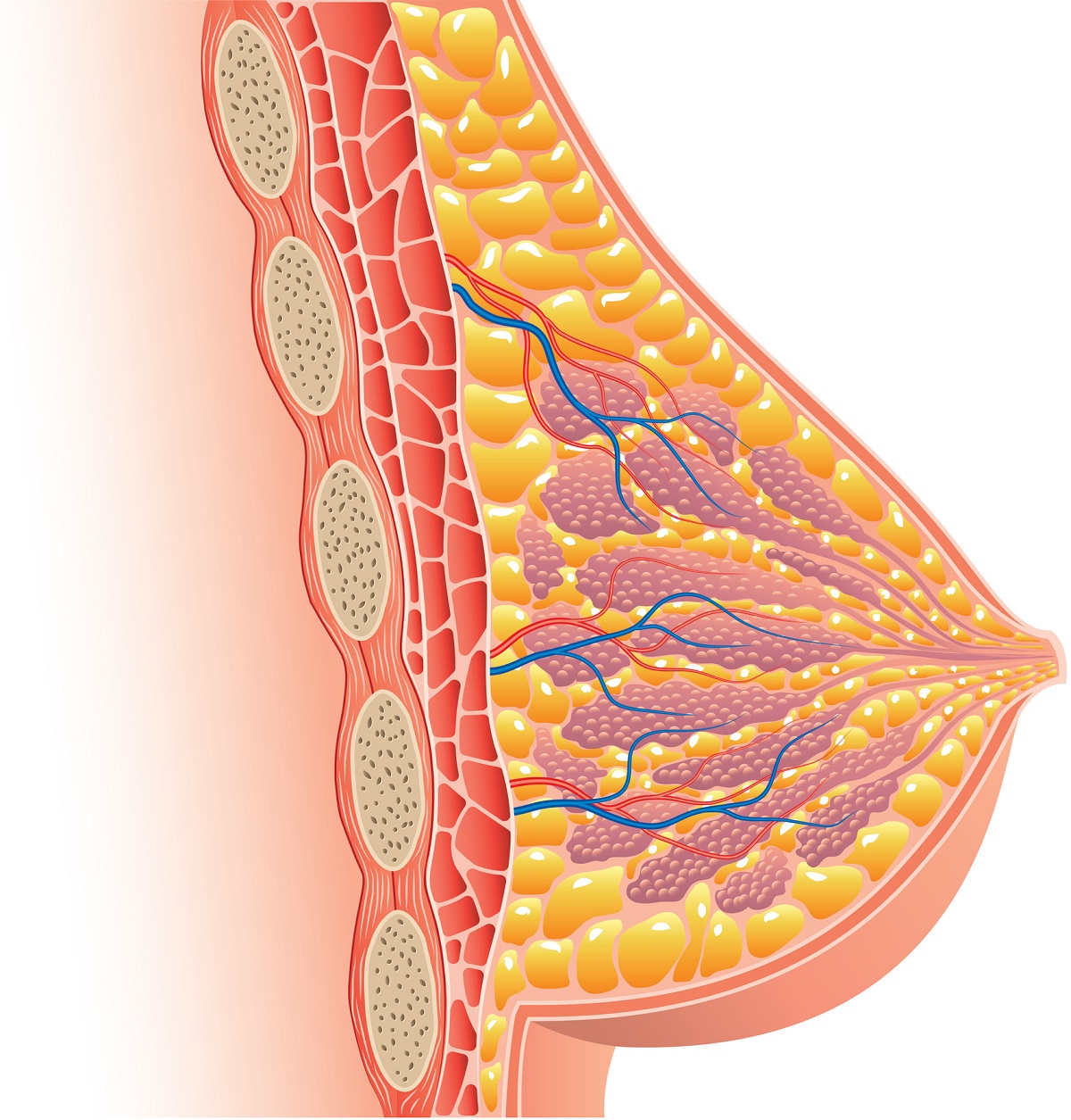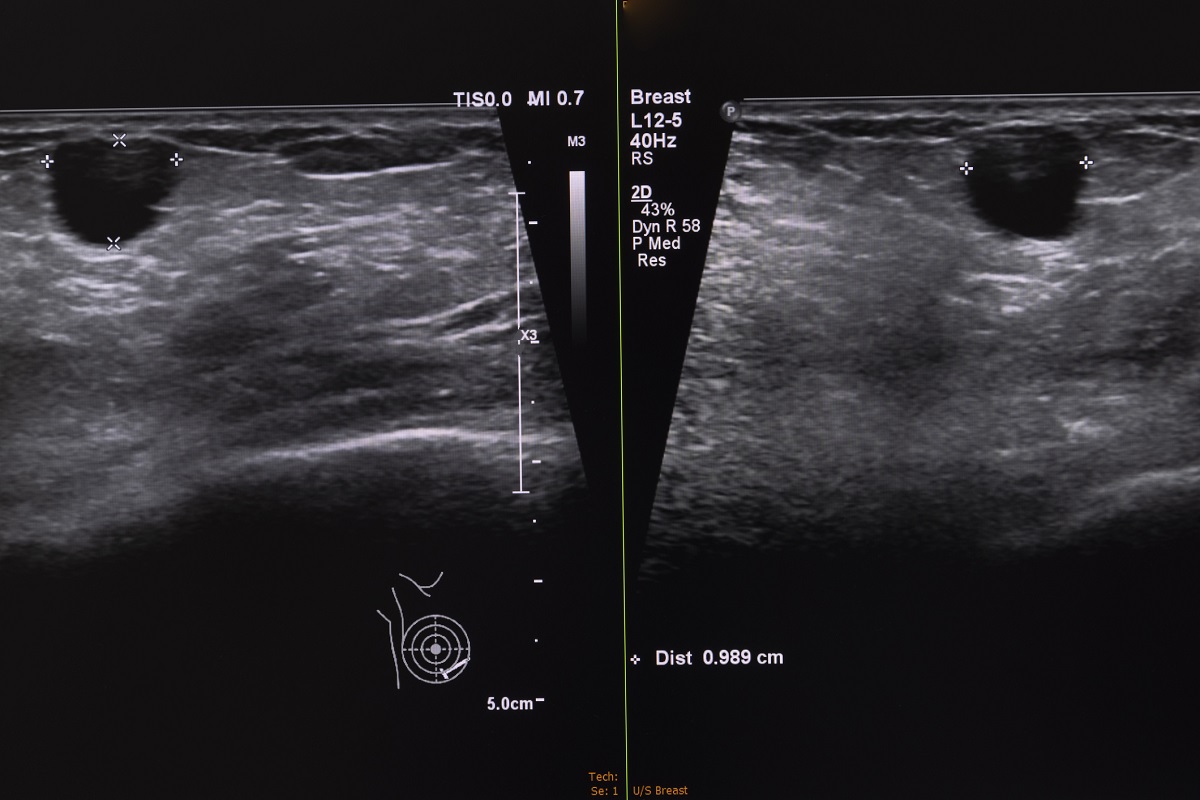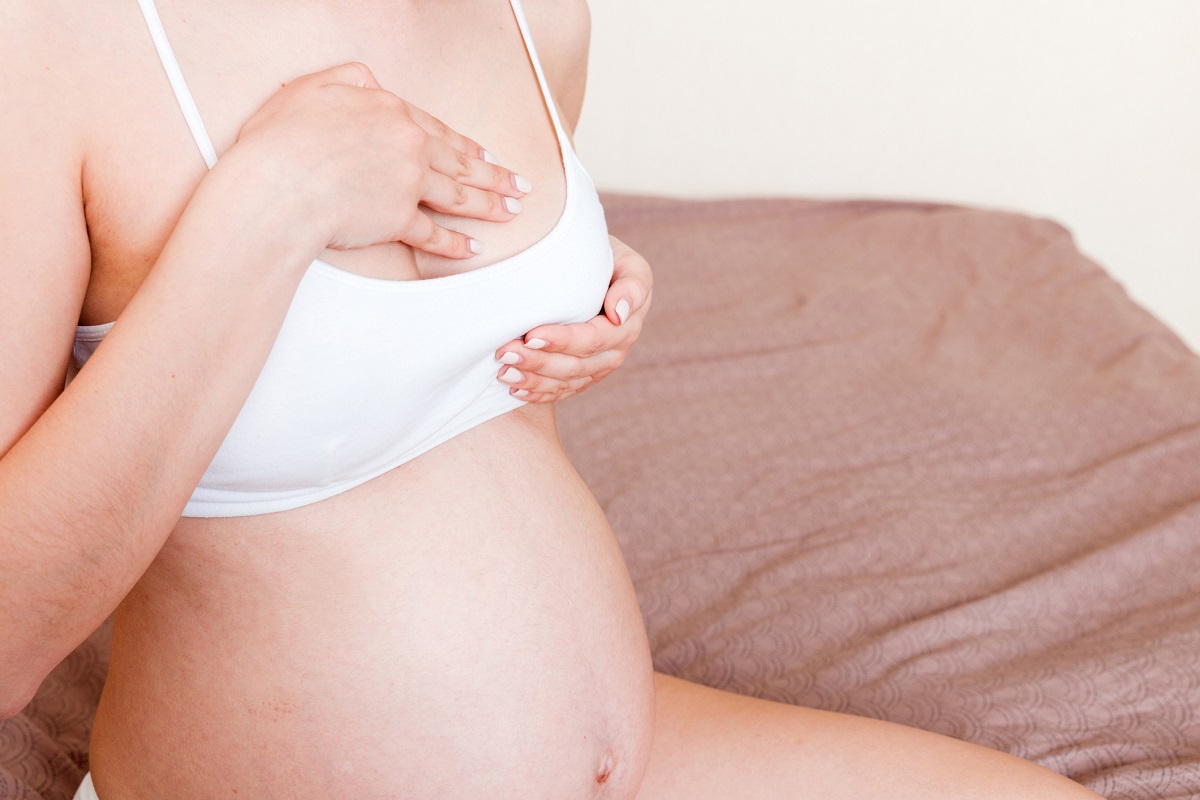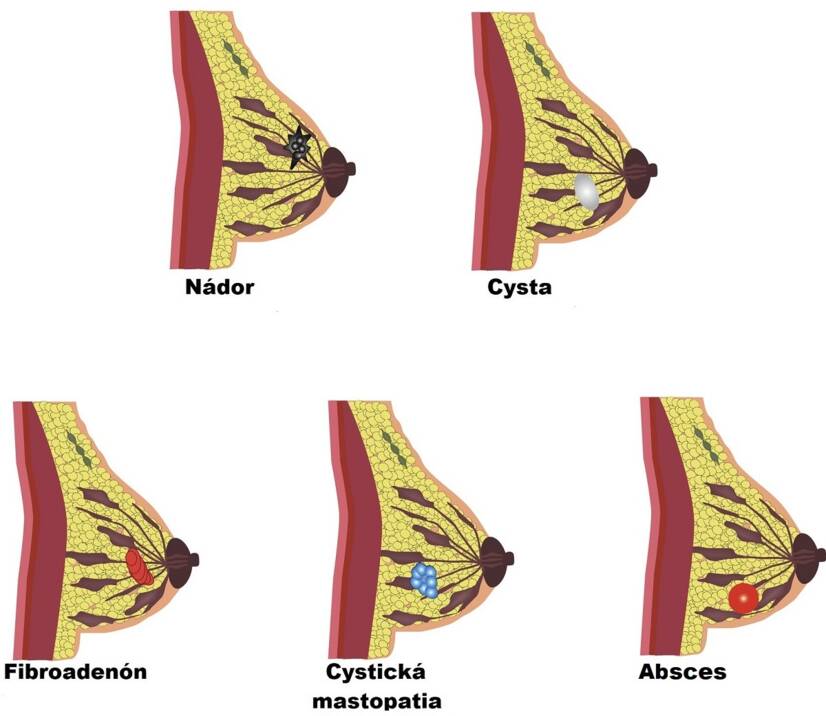- indol3c.sk - Nodules, lumps, cysts in the breast?
- fmed.uniba.sk - Basics of mammology: Kamil Pohlodek
- mayoclinic.org - Cysts in the breast
- breastcancernow.org - Cysts in the breast
- whattoexpect.com - Finding breast lumps during pregnancy
Cyst in the breast (lump): what are the symptoms? Pain may not be present

A cyst in the breast is a hollow anatomical formation of varying size. It is separated from its surroundings by its own wall. The inside of the cyst may be filled with fluid or connective tissue. It may have several causes.
Most common symptoms
Characteristics
A breast cyst is a fluid-filled sac, larger or smaller in volume, located inside the breast.
The medical field dealing with breast diseases is called mammology. It is included in the field of gynecology and obstetrics. This field includes diagnosis, surgery, pathology and treatment.
Anatomy of the breast
The breast consists of the mammary gland and the surrounding connective tissue. It has a nipple with an areola. It is more pigmented, i.e., darker in colour, and more circumscribed from the skin.
The change in pigment colour of the nipple occurs mainly during pregnancy when the nipple is darker.
The mammary glands, sebaceous glands and sweat glands are located at the edge of the areola.
The size of the breast and its mass undergoes various changes during life due to the menstrual cycle, age, pregnancy and breastfeeding.
The role of the breast is to produce and secrete milk.
The content of breast tissue in the breast determines the size and shape of the breast.
Breast tissue often appears lumpy on examination. If a new lump appears, does not disappear and persists after one or two menstrual cycles or becomes larger, it is important to see a gynaecologist and not to delay the examination.

The breast glands are affected by hormones during the menstrual cycle, during pregnancy, breastfeeding and menopause.
A cyst in the breast is a fluid-filled cavity that most often shrinks or absorbs within a few days to weeks. If the cyst enlarges, a puncture needle is used to suction out its contents and reduce its volume.
The occurrence of cysts in a woman's breast is common and is related to the menstrual cycle. They may form sporadically or may be congenital.
Cysts can form at any age in women. However, they are more common in the pre-menopausal period, in women under the age of 50. They can occur in one breast or in both breasts at the same time.
Sometimes a lump and cyst in the breast can also occur in children at a young age or in men.
Most breast cysts are benign formations that do not tend to metastasize. It is not necessary for a woman to immediately think of every lump in her breast as cancerous.
Often it is a non-cancerous cyst.
Nevertheless, cysts must not be underestimated. They can still be tumours such as benign papilloma or even malignant carcinoma, but these are common in women over 40.
Classification of types of cysts found in the breast
Fibrous mastopathies are breast changes that take place in glandular tissue.
Cystic mastopathy means that a large number of small cysts are found in the breast.
The combination of fibrous mastopathy and cystic mastopathy is called fibrocystic mastopathy. It occurs mainly between the ages of 40 and 50, when changes in the structure of the mammary gland are caused by sex hormones and the formation of nodules - cysts.
Fibroadenomas occur in women from about age 20 to age 40, when benign tumors form in the breast. Their growth is slow, they are often mobile and painless under the skin.
Cysts are fluid-filled sacs that affect sex hormones during the menstrual cycle. Their size changes during the month due to hormones.
They appear at any time during a woman's life and rarely in women after the age of 50. These cysts are benign, mobile under the skin and soft. Sometimes a woman can't feel them. Sometimes they are sensitive to the touch and even painful.
Abscesses are sacs filled with pus and are quite painful. Most often, an abscess occurs in the case of breast inflammation. In the case of an abscess, the skin at the site of the formed inflammatory deposit is red, hot or hard.
Lipomas are benign tumors that vary in size. Sometimes there is one lipoma in the breast, sometimes several at once.
Intraductal papillomas, also called mammary duct papillomas, are among the benign tumors of the mammary gland. They often present with bloody or milky discharge from the nipple.
An atheroma is a fatty lump that has formed by blockage of the sebaceous gland. When palpated, it is spherical, about the size of a pea, but can grow to larger sizes. Microcysts cannot be felt by touch. They are too small but can be detected by mammography or sonography.
Macrocysts are large, palpable and range in size from 2.5 cm to 5 cm in diameter.
Causes
The cause is not exactly known. Cysts arise due to hormonal changes in the menstrual cycle.
Why do cysts form?
Breast tissue is made up of glands in which milk is formed during breastfeeding. Through their ducts, milk is drained into the nipple. These mammary glands are surrounded by breast tissue in the breast, which is made up of tissue and fat.
The breasts change with age due to hormonal changes and the hormone estrogen. It is this hormone that causes the formation of fluid in the breast.
When the mammary glands fill with fluid, a cyst forms in the breast.
Many times cysts also form from excess estrogen or other hormones.
A cyst can occur at any age. It is more common after the age of 35.
After menopause, levels of the hormone estrogen drop. Most cysts stop forming.
Breast cysts can also form due to heredity or can be congenital. In most cases, it is a process that takes place during a woman's lifetime.
Genetics and heredity are predisposing factors, especially in the case of carcinomas, i.e. malignant breast cysts. In the case of inflammation of the breast, for example, it is a cause acquired during life.
Wearing a comfortable bra that does not compress or restrict the breasts is recommended as a measure to prevent or limit the development of a breast cyst.
Symptoms
Women often discover a small lump in the breast during breast self-examination, which may be round or oval in shape.
Changes in the breast, where a woman often feels a lump or a hardened lump or swelling, occur especially in the second half of the menstrual cycle. They often manifest as breast tenderness.
Most cysts can be detected during a preventive breast examination using sonography, mammography or by palpation by a gynaecologist during an examination. A cyst is easiest to detect if it is sufficiently nodular and hard or if it is within easy reach from the outside.
However, cysts can also be very small or non-palpable, in which case they are difficult to detect and asymptomatic development of the cyst is possible.
If they are large, it is usually possible to observe a small swelling or redness of the skin on the breast in addition to the lump.
Cysts are palpable as oval or round lumps. They may be soft or hard and may also be mobile under the skin.
Their size can range from a few millimeters to several centimeters.
Breast cysts are more common in women, but can also occur in men and children.
How does the presence of a cyst in the breast manifest itself?
Many women are unaware of a breast cyst because they have no symptoms.
Others experience pain and tenderness in the breast.
However, a cyst may more often manifest itself with pain in the upper, outer side of the breast or an uncomfortable feeling in the breast.
Sometimes increased breast tenderness is noticed at certain times of the menstrual cycle due to changes in hormones in the body.
Increased breast tenderness especially in the area where the cyst is located is just before menstruation.
Approximately 20% of women may experience a whitish nipple discharge.
Nipple discharge may be clear, white, yellow or brown.
After menstruation, all symptoms, such as pain, are usually relieved. The volume of the cyst also decreases.
The presence of cysts in the breast does not increase the risk of cancer. However, if they are present, it may be more difficult to find a new lump in the breast or to notice other changes.
Diagnostics
Cysts can be diagnosed by palpation.
When palpating, it is also necessary to palpate the lymph nodes in the armpit. In some cases of inflammatory diseases, they may be swollen. These inflammations may be directly related to the formation of a cyst in the breast if it is inflammatory in nature.
Sonography (mamosonography) is an examination method for imaging the internal structure of the breast using ultrasound waves.
During the examination, the patient lies on her back with her hands behind her head. The sonographic head is passed over the breast using a gel. The ultrasound shows round or oval-shaped cysts with a clear outline.

Mammography is a special examination of the breast using X-rays. The mammographer measures the density of the tissue using X-rays that pass through the breast tissue. For better diagnosis and passage of the X-rays, the breast is compressed between two compression plates during the examination.
Mammography is recommended for women over the age of 40. In women under the age of 40, it is sometimes necessary to refine the evaluation of the cyst.
A sample is taken from the breast cyst to evaluate its contents by suctioning or taking a tissue sample.
Aspiration of the contents. Aspiration is performed by inserting a fine needle into the cyst from which the contents are aspirated.
The fluid may range in colour from clear to very dark.
If the fluid does not contain blood, is straw-coloured and the cyst disappears by aspiration, no further examination is necessary.
If the fluid is bloody and the cyst does not disappear, a sample is sent for examination and the woman is then referred to a breast doctor who determines the next course of treatment.
If no fluid drains from the cyst, the doctor will send you for a mammogram or sonogram. This means that the cyst is solid with no fluid content. In this case, a tissue sample may be taken from the cyst for a biopsy to determine if the cyst has a cancerous base.
Course
The formation of a cyst is most often due to a hormonal imbalance or some kind of inflammation.
Such cysts are usually not dangerous and may also manifest with breast or nipple tenderness.
In the case of cancerous cysts, the development can be very rapid. A small lump may become a cyst with a large deposit or may metastasize to the surrounding area. It may spread to other tissues or organs and invade them.
Cyst in the breast during pregnancy
Are you pregnant and have you discovered a lump in your breast? Is there a reason to panic?
Most likely, there is nothing to worry about. The occurrence of breast cancer during pregnancy is very rare.
During pregnancy, many changes occur in the breast tissue. Your breasts may be heavier and firmer. The lumpy tissue is more tender to the touch than before pregnancy.
The most common reason for cysts in the 2nd and 3rd trimesters may be a blockage in the milk duct. The blockage may manifest as a lump to swelling and possible tenderness.
If you notice a lump in your breast, tell your gynaecologist. The gynaecologist will refer you for a sonographic examination of your breast.
If the cyst is caused by a blockage in the milk duct, warm compresses on the breast and massaging the cyst area are recommended.
Clogged milk ducts appear as hard lumps in the breast. They usually disappear within a few days.
Breast lumps most often appear in the 3rd trimester of pregnancy.

The occurrence of cysts during breastfeeding
Your breasts go through various hormonal changes during pregnancy and during breastfeeding to enlarge the breasts and fill them with milk.
These changes will return to their original state within 3 months of stopping breastfeeding.
Cysts in the breast tissue or in the milk ducts during breastfeeding can cause milk to stop flowing through the milk ducts by their pressure. If the outflow of milk stops, milk production will also start to stop.
Pregnancy and breastfeeding can cause fibroadenomas, which are related to the menstrual cycle.
How it is treated: Breast cyst - a lump in the breast
Breast cyst treatment: drugs or surgery? Sometimes it disappears on its own
Show moreSymptoms of breast cancer
Gallery




Cyst in the breast is treated by
Other names
Interesting resources










